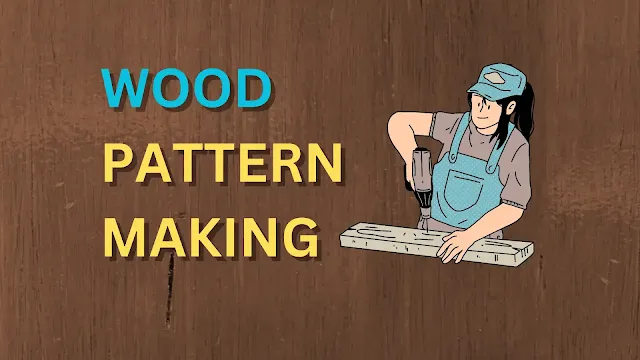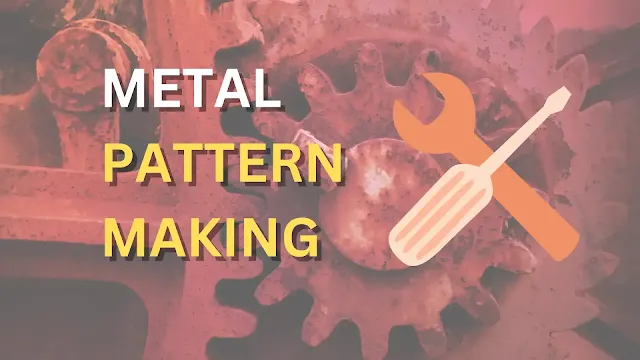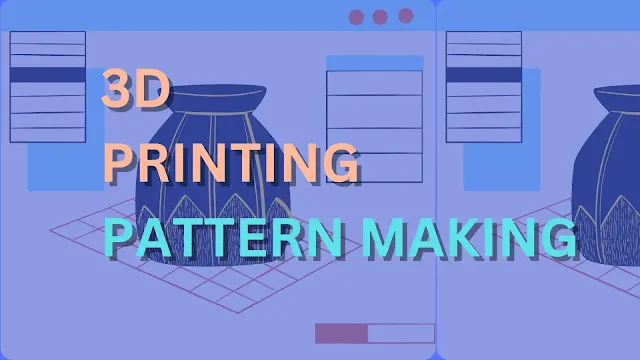Pattern Making In Casting Process
A pattern is an essential tool for making cavities in the sand mould where molten metal is solidified to make a final casting.
The pattern does not only find its application in sand moulding but is widely used in investment casting, slurry moulding and shell casting processes.
Patterns are required to make desirable casting according to the needs of the customer.
These patterns are produced using a pattern-making process using various machines and pattern materials such as metal, wood, plastic, polystyrene, thermocole, plaster of paris and wax to suit the requirements of the final customer, engineer, foundry operator and pattern designer.
Every pattern material uses different machines, tools, equipment, methods, processes and operator skills to manufacture simple to complex patterns.
I have explained below pattern making step by step process along with various pattern-making processes/methods for various pattern materials.
Mechanical engineering students should read the following discussion related to making patterns which I have explained with diagrams, steps and summary.
{tocify} $title={Pattern Making Table of Content }
Pattern-making is the first and most important step in sand casting (wood, metal and plastic pattern), shell casting (sand+resin pattern) and investment casting (metal and wax pattern) to produce sound consistent high-quality casting.
Pattern making in the casting process involves creating a model called a pattern used to create an impression/cavity in the sand mould.
While designing a pattern what pattern-making allowances should a pattern designer consider?
While making patterns it becomes important to consider pattern-making allowances such as shrinkage allowance, distortion allowance, shake allowance, machining allowance and draft allowance.
These allowances are given on the pattern considering the relation between pattern and mould while pattern removal (draft and shake allowance), changes that pattern goes through different changes in shapes and size during moulding (metal pattern-shrinkage allowance) and allowance given to pattern for secondary operations (machining allowance).
What elements of the gating system should the pattern makers consider while making a pattern?
Pattern makers should design patterns considering feeding and gating systems in the mould. Gating systems such as pouring basin, sprue, runner, gate and riser must be considered while making patterns.
In patterns such as gated patterns, match plate patterns and cope & drag patterns entire gating system is attached to the pattern directly and then mould cavity/cavities are produced.
How important is considering the core, core print, chills, padding and chaplet position during pattern making?
Apart from the gating system, pattern makers should consider the core position, core prints, chaplets, chills and padding in the mould and design the pattern accordingly.
Few casting require support from core prints and chaplet, pattern should be made considering the location of these elements in the mould. Padding and chills are added in and around the mould to improve directional solidification to reduce distortion, the pattern should be designed accordingly keeping in mind these components.
The mould plane, parting line, type of sand and section from where the pattern will be withdrawn from the mould are selected based on the final pattern.
The pattern is designed and made in such a way that the final casting cast is of desirable shape, size, accuracy and tolerance.
The person who makes patterns in the foundry is called a pattern maker.
On what factors pattern-making process is dependent?
Pattern-making depends upon the following factors:
- The complexity and design of the pattern to be manufactured.
- The material used for making patterns.
- Size, shape, dimensions and structure of the pattern.
- Surface finish, tolerances and accuracy of pattern.
- Pattern weight and handling of pattern in the foundry.
- The gating system, chaplet, padding, chills, cores and core prints are used in the moulds.
- Type of patterns used in the sand casting process.
- Cost of pattern material and cost of pattern production.
- Reliability, life, and durability of the pattern.
- Pattern-making allowance and pattern material.
Step By Step Pattern Making Process
- Step 1: Select software for the design of patterns such as CAD and AutoCast.
- Step 2: Decide a parting line, and parting plane and decide the location of the core and core print concerning the pattern and the mould cavity.
- Step 3: Select a pattern material for pattern making based on types of sand and the size, design, shape, undercuts, weight, dimensions, cost, workability, machinability and complexity of the pattern.
- Step 4: Give pattern-making allowances during the pattern making the pattern to compensate for the change in the casting material.
- Step 5: Provide rigs on the pattern section. Rigs are given to the pattern so they can be handed, lifted and transported in the foundry.
- Step 6: Use the pattern-making techniques that I have mentioned below to manufacture patterns and assemble the pattern pieces together.
- Step 7: Colour code the final pattern to simplify the mould cavity-making process for a mould maker.
- Step 8: Produce core, core prints and support that are to be placed in the mould cavity to produce holes in the casting and align with the final pattern.
To make a pattern, the pattern maker selects the best pattern material from the numerous options available.
Pattern materials for pattern making are selected based on the properties of pattern material and various factors for the selection of pattern material.
After the pattern material is selected pattern is designed and manufactured keeping in mind pattern-making allowances.
Techniques used for pattern making for various materials are as follows:
- Wood pattern making.
- Metal pattern making.
- Plastic pattern making.
- Wax pattern making.
- Foam pattern making.
- 3D printing pattern making.
Wood Pattern Making In Casting

|
| (a) Wood Pattern Making |
Wood pattern making involves using wood as a patterned material for producing a simple shape wood pattern such as single piece pattern, split piece pattern, skeleton pattern, segmental pattern and sweep pattern.
The wood pattern is made in the carpentry department using a wood lathe machine.
How to make wood patterns for casting?
Step By Step Process For Making Metal Pattern
Wood pattern-making consists of the following steps:
- Step 1: Draw and design a wooden pattern to be made.
- Step 2: Consider all allowances and select the best wood material suited for making patterns.
- Step 3: Shape wood on a wood lathe machine in the carpentry department.
- Step 4 Assemble pattern parts together with glue, nuts and bolts to make the final pattern.
- Step 5: For making a larger size pattern the stop-off pieces are used to support the structure of the pattern.
- Step 6: Use wooden fillets avoiding sharp corners to reduce stress concentration in the final casting during solidification.
- Step 7: Flat, gear, cylindrical, rectangle and ring shape patterns are made in the carpentry department.
- Step 8: Polished pattern to achieve a better surface finish for final casting.
- Step 9: Apply varnish, lacquer and polyurethane to eliminate any moisture and humidity in the wood material.
- Step 10: Single-piece patterns, split-piece patterns, skeleton patterns, and segmental patterns are widely manufactured by wood under the carpentry department.
Metal Pattern Making In Casting

|
| (b) Metal Pattern Making |
Metal pattern-making involves using metal material to create a pattern for sand casting and shell moulding or shell casting process. Material such as aluminium, cast iron, copper and stainless steel.
Metal patterns are made under the turning, welding, drilling, milling, metal forming and grinding departments.
Metal patterns are used for manufacturing metal patterns such as match plate pattern.
Step By Step Process For Making Metal Pattern
Metal pattern-making consists of the following steps:
- Step 1: Design and draw the metal pattern to be manufactured.
- Step 2: Select an appropriate metal material for pattern making.
- Step 3: Allocate allowances along the double shrinkage allowance to make a pattern.
- Step 4: Metal pattern-making starts on the lathe machine, and milling machine, parts are further joined using welding, brazing and soldering processes.
- Step 5: Apply paint, powder coat and oil to avoid corrosion on the metal pattern material.
- Step 6: The metal pattern now is ready for the sand-casting process.
Plastic Pattern Making

|
| (c) Plastic Pattern |
Plastic pattern making consists of making a pattern out of different types of plastic to produce complex lightweight patterns.
Step By Step Process For Making Plastic Pattern
Plastic pattern-making consists of the following steps:
- Step 1: Design and draw a blueprint of the plastic pattern to be made according to the final casting.
- Step 2: Select an appropriate plastic material to make a plastic pattern.
- Step 3: Provide pattern allowance on the pattern.
- Step 4: Make the die according to the pattern dimensions.
- Step 5: Use the injection moulding process to make a plastic pattern in large quantities.
- Step 6: A small plastic pattern can be made on a customized plaster mould.
- Step 7: Take the pattern out of the mould and get it ready for casting.
Wax Pattern Making

|
| (d) Wax Pattern Making |
Wax pattern-making involves making patterns out of a different kind of wax material.
Step By Step Process For Making Wax Pattern
The steps required for making a pattern out of wax are as follows:
- Step 1: Design and draw a print of wax pattern to be produced according to the final casting.
- Step 2: Select an appropriate wax material for making a pattern.
- Step 3 Provide pattern-making allowance to the wax pattern.
- Step 4: Make a mould cavity which is a negative replica of a wax pattern.
- Step 5: Pour the wax into the mould and remove the pattern after the pattern solidifies.
- Step 6: The pattern is ready now to be used in the casting process.
3D Printing Pattern Making In Casting

|
| (e) 3D Printing Pattern Making |
3D pattern making consists of making patterns using rapid prototyping and 3D printers.
3D printing is a new technique using a 3D printer to create patterns with different materials including metal, wax and plastic for manufacturing patterns.
3D printing pattern gives high flexibility in pattern making designing and pattern material selection.
Different kinds of modelling such as additive manufacturing, fused deposition modelling (FDM), digital light processing (DLP) and stereolithography (SLA) are used for producing 3D pattern models.
3D pattern printing technology gives high flexibility for producing complex shapes of different shapes and sizes which are difficult to produce by the traditional pattern-making process explained earlier.
3D printed patterns can be made fast with high efficiency giving accurate patterns with close dimensional tolerance. This pattern can be made in less time in low volumes.
This printed pattern-making process is accurate in producing patterns as compared to traditional pattern production methods.
Pattern Making In Foundry Conclusion
Pattern making in the manufacturing process is a critical and crucial step for producing a desirable sand casting in the sand casting process.
There are 17 types of pattern in casting process made from the pattern-making method used for producing sand casting.
The quality of the final casting depends upon many factors such as the quality of molten metal, the quality of sand and the solidification process but the quality of the final casting is mainly dependent on the quality of the pattern.
Patterns and tooling are also used for producing other high-tolerance wax patterns in the investment casting process.
Desirable wood patterns are made under the carpentry department while metal patterns are made under the turning, welding, drilling, grinding and foundry departments.
Wax material and plastic materials are moulded to make lightweight but complex shape patterns.
New developments in rapid prototyping, multi-jet printing (MJP) and 3D modelling improve overall reliability in the pattern production techniques in the manufacturing process.
CNC machines, laser cutting machines, selective laser sintering, fused deposition modelling, vacuum forming machines and water jet cutters are used for making patterns.
A pattern should have high quality and dimensional accuracy which can be achieved with high-quality modelling, rapid prototyping and CAD/CAM data.

